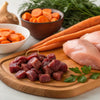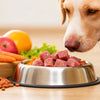How to Portion Raw Dog Food: A Comprehensive Guide for Pet Owners
- Houndsy
Table of Contents
- Introduction
- Understanding Your Dog's Nutritional Needs
- Calculating Portion Sizes for Raw Dog Food
- Transitioning to Raw Dog Food
- Practical Tips for Portioning Raw Food
- Storing Raw Dog Food Properly
- Why We Love the Houndsy Kibble Dispenser for Raw Feeding
- Conclusion
Introduction
Did you know that the way we portion our dog's food can significantly influence their health and overall well-being? A staggering number of pet owners grapple with the challenge of feeding their dogs raw diets, often resulting in either overfeeding or underfeeding. This reality not only complicates feeding routines but also creates potential health risks for our furry friends. As enthusiasts in the pet care space, we at Houndsy recognize that an informed approach to portioning raw dog food is essential for nurturing happy, healthy dogs.
In this blog post, we aim to demystify the process of portioning raw dog food, providing practical tips, guidelines, and insights. By the end of this article, you’ll be equipped with the know-how to accurately portion your dog’s raw meals, optimizing their health, and ensuring a feeding routine that’s both effective and enjoyable.
Our exploration will include understanding the nutritional needs of dogs, calculating the right portion sizes based on specific criteria, methods for cooling and storing raw food, and how the innovative design of the Houndsy Kibble Dispenser can simplify your feeding experience. Reflect on your current feeding practices as we delve into this important topic!
Understanding Your Dog's Nutritional Needs
Different Factors Influencing Nutritional Requirements
Each dog is unique with their own set of dietary needs that depend on several factors:
-
Age: Puppies require considerably more calories than adults due to their growth, often about 4%-6% of their body weight daily compared to 2%-3% for adult dogs.
-
Weight: A dog’s ideal body weight will dictate how much food they need. An overweight dog will require fewer calories than an underweight one.
-
Activity Level: Active dogs need more calories than sedentary dogs. Adjust portion sizes based on your dog’s daily exercise routine.
-
Health Condition: Certain medical conditions can influence a dog’s dietary needs. It's essential to consult a veterinarian when in doubt.
In addition to these factors, we must also consider the balance of nutrients in raw dog food, which typically includes meat, organs, and bone. This balanced raw diet mimics what dogs naturally consume, thus contributing to overall health.
Basics of Raw Dog Food Diet
Raw dog food diets can include a selection of animal proteins, organ meats, and raw bones, promoting a diet similar to what canines would eat in the wild. Such a diet is rich in nutrients and often more digestible than processed foods. Research has shown that raw diets can lead to healthier skin, shinier coats, and improved energy levels.
However, transitioning to a raw diet requires careful considerations and knowledge about proper feeding portions, as the wrong ratios can lead to serious health issues.
Calculating Portion Sizes for Raw Dog Food
General Guidelines for Portioning
As a general guideline, here’s how you can calculate the appropriate amount of raw food for your dog:
-
Adult Dogs: Feed between 2-3% of their ideal body weight per day.
-
Puppies: Feed between 4-6% of their current weight daily, given their rapid growth.
For example, if you have a 50-pound adult dog, you would feed them anywhere from 1 to 1.5 pounds of food each day. Conversely, if you have a 10-pound puppy, you may need to provide between 0.4 to 0.6 pounds daily.
Using Weight as a Baseline
Utilizing a digital scale can provide accuracy when portioning raw dog food. Here's a breakdown based on a dog’s weight and activity levels:
-
Low Activity (2%): For a 50-pound dog, feed approximately 16 oz.
-
Moderate Activity (2.5-3%): For a 50-pound dog, this would be about 20-24 oz.
-
Weight Gain (3.5%): For a 50-pound dog, approximately 28 oz may be appropriate.
Adjusting Portions Based on Body Condition
Regularly monitor your dog's body condition score (BCS). This visual assessment considers fat coverage on ribs and body shape, helping you adjust food recourse accordingly. A healthy feeding routine creates a continual state of evaluation. As they change physically—whether from growing up or aging—you should adapt their raw food portions.
Transitioning to Raw Dog Food
The Importance of Gradual Transitioning
When transitioning your dog to a raw diet, sudden shifts can cause digestive distress. Instead, it's essential to gradually incorporate raw foods into their current diet over approximately 7 to 10 days.
-
Days 1-2: 25% raw food, 75% current diet.
-
Days 3-4: 50% raw food, 50% current diet.
-
Days 5-6: 75% raw food, 25% current diet.
-
Day 7: 100% raw food.
During this transition, it’s crucial to observe for any signs of discomfort or digestive upset.
Common Adjustment Challenges
As your dog adjusts to raw feeding, you might encounter these common challenges:
-
Stool Changes: Expect different poop sizes and shapes as a result of the increased protein and lower filler content.
-
Constipation or Diarrhea: If you notice inconsistent bowel movements, consider adjusting the proportion or adding fiber (such as pumpkin puree) to their diet.
Practical Tips for Portioning Raw Food
Using Tools for Precision
Digital Scales: Invest in a quality digital scale that can weigh food with precision. This not only aids in achieving consistent portions but also simplifies tracking your dog’s intake.
Scoop and Measure Appropriately: If you prefer to measure portions with scoops, make sure to standardize what is meant by a "scoop" through weighing your own scooping method on a scale first.
Meal Prepping for Efficiency
Prep all the raw food for a week ahead, if you reserve adequate cooling storage and adhere to hygiene regulations while handling raw meat. Portion out meals in containers or bags and store them in the freezer, ideally thawing them in the refrigerator the night before they are needed.
By having meals prepped in advance, you're also eliminating guesswork around daily portions. The industry-leading design of the Houndsy Kibble Dispenser offers high-quality materials and innovative solutions for these meal prep challenges—allowing you an elevated feeding experience while maintaining style.
Storing Raw Dog Food Properly
Temperature Considerations
Storing raw food correctly is of utmost importance to prevent bacterial growth:
-
Freezing: Freezing raw food right after purchase ensures maximum freshness. When ready to use, thaw your pet’s meal in the refrigerator overnight or in cool water for rapid thawing.
-
Refrigeration: Unused thawed portions should be kept in airtight containers, ensuring to consume them within 3–5 days.
Hygiene Best Practices
Ensure to practice good hygiene when handling raw food. Always sanitize surfaces and equipment, and wash your hands thoroughly after touching raw ingredients. Using gloves can also limit the risk of contamination.
Why We Love the Houndsy Kibble Dispenser for Raw Feeding
At Houndsy, we believe feeding should be as beautiful as it is functional. Our Houndsy Kibble Dispenser is the perfect companion in your raw feeding journey. With features designed specifically for pet owners, including:
-
A convenient crank at standing height, alleviating the need for bending.
-
An auto-locking mechanism that prevents accidental dispensing, ideal for curious pets or toddlers.
-
A large storage capacity ranging from 25-30 lbs to ensure you have enough food for your beloved dog.
With our dispenser, portioning raw dog food becomes easier and more efficient, transforming the feeding ritual into a delightful experience!
Conclusion
Mastering the art of portioning raw dog food is crucial for the health and happiness of our canine companions. By understanding the factors that influence their dietary needs and leveraging practical tips, we can create a feeding routine that enhances their overall quality of life. Each dog's journey into raw feeding is unique, and taking the gradual approach in portions can greatly ease the transition and troubleshooting process.
As we cultivate new feeding practices, consider introducing tools designed to simplify life, such as the Houndsy Kibble Dispenser. It can help keep your feeding experience streamlined and enjoyable while maintaining an aesthetic that complements your home decor.
Encourage yourself to reflect on your current feeding practices. How are they serving your furry friend's needs? With the right knowledge and tools, you can elevate this daily ritual, ensuring your beloved dog receives the attentive care they deserve.
FAQ
What are the primary nutrients in raw dog food? Raw dog food should ideally contain proteins and fats from meat, organs providing necessary vitamins, and bones supplying calcium.
Can I feed my dog raw bones? Yes, raw bones can be beneficial for teeth and nutrition, but avoid cooked bones as they can splinter and pose a danger to your pet.
How often should I weigh my dog for portion control? Weigh your dog regularly, especially after significant diet changes, and consider noting any changes in body condition to adjust portions accordingly.
Is a raw diet right for every dog? Not every dog tolerates a raw diet well. Always consult your veterinarian before making dietary changes, especially for dogs with existing health conditions.
How should I thaw raw dog food? Raw food can be thawed in the refrigerator overnight or under cool water, never at room temperature to minimize bacterial risk.
By ensuring that your dog receives the proper nutrition through calculated portions and making use of innovative feeding solutions, we can ensure they lead healthy, active lives. Visit our product page to explore the features of the Houndsy Kibble Dispenser that simplify and elevate your dog feeding experience!












